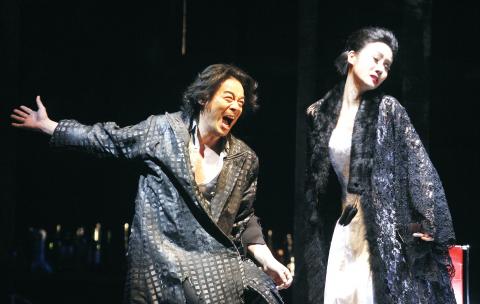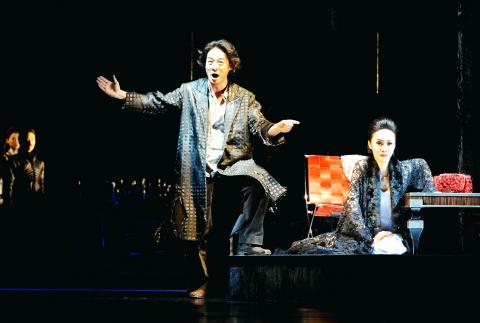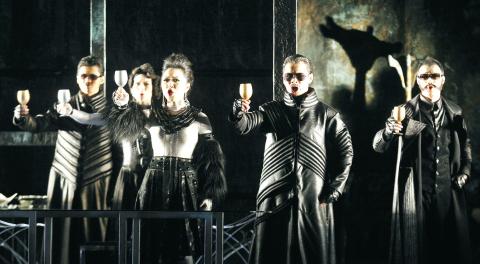The National Theater Concert Hall’s (NTCH) Taiwan International Festival of Arts 2011 gets underway this weekend with a star-studded musical adaptation of La Dame aux Camelias (茶花女) in the main theater and an outdoor carnival that features an unusual combination of French theater and lion dancing.
The outdoor show at the Chiang Kai-shek Memorial Hall Plaza tomorrow night is the official kickoff to this year’s festival, which comprises 15 productions and runs through March 26. Three groups will perform at the family-centered carnival — Ten Drum Art Percussion Group (十鼓擊樂團), the Hung Sheng Lion Dance Theater (鴻勝醒獅團) and La Compagnie des Quidams.
The 10-year-old Ten Drums first gained worldwide attention when their album Island of Drums was nominated for a Grammy in 2008, while the Hung Sheng troupe has worked to redefine lion dancing by incorporating more theater and martial arts into its performances. The French troupe is famed for its very otherworldly look, with white costumes that bring to mind a cross between the Michelin Man and a lamp — large puffy bodies with heads that light up.

Photo: Taipei Times
While the weather bureau forecasts that temperatures will drop today and tomorrow, the three troupes should generate enough energy between them to keep the crowds in the plaza warm.
The temperature should be a lot hotter in the National Theater, where burning passion is the theme of the weekend. The NTCH’s newest flagship production, La Dame aux Camelias, conceived and directed by Japanese director Tadashi Suzuki, had its world premiere last night.
For more than four decades, Suzuki has honed his unique, intense training methods, which teach actors to focus on their breathing and foot movements as a way of centering their energy and learning how to make their entire body speak, even when they are silent. His performers’ physical intensity has become a hallmark of his works and his training methods are now taught and used at institutions around the world, from the Juilliard School in New York to the Royal Shakespeare Company. As a director, he has gained fame from his reinterpretations of Western classics that break through cultural boundaries, including The Trojan Women, King Lear, Oedipus Rex and Cyrano de Bergerac (which his company brought to the National in 2009).

Photo: Taipei Times
“I am always more interested in bringing together different cultures and people in a single production ... than having similar people do similar things,” Suzuki told a press conference in Taipei last month.
La Dame aux Camelias tells the story of Marguerite Gautier, a Paris courtesan, who gives up the love of her life, Armand Duval, so that he won’t be ruined by his association with her. Giuseppe Verdi used the story for his opera La Traviata, but Suzuki wanted a more contemporary look.
The musical is set in “contemporary Europe,” but the cast, led by Weng Ning-chien (翁寧謙) as Marguerite and Chou Ming-yu (周明宇) as Armand, and the songs are all modern Taiwanese love ballads that should be familiar to local audiences.

Photo: Reuters
Weng and Chou spent a month last year training with Suzuki’s own troupe in Togo, Japan, as part of their rehearsal process.
As has been the case with previous NTCH flagship productions, the costumes — this time by Lin Ping-hao (林秉豪), who is also credited with the makeup — are stunning.
The show will be performed in Chinese, with English subtitles. There is a pre-show talk — in Mandarin —in the lobby that starts a half-hour before each performance, and after Sunday’s matinee there will be a “meet the artist” session in the theater.
The NTCH is taking this production down south later this month for two shows in Greater Kaohsiung — only the second time it has taken one of its flagship productions on the road. The first was Legend Lin Dance Theatre’s (無垢舞蹈劇場) Song of Pensive Beholding (Chants de la Destinee, 觀) in July last year.

Beijing’s ironic, abusive tantrums aimed at Japan since Japanese Prime Minister Sanae Takaichi publicly stated that a Taiwan contingency would be an existential crisis for Japan, have revealed for all the world to see that the People’s Republic of China (PRC) lusts after Okinawa. We all owe Takaichi a debt of thanks for getting the PRC to make that public. The PRC and its netizens, taking their cue from the Chinese Communist Party (CCP), are presenting Okinawa by mirroring the claims about Taiwan. Official PRC propaganda organs began to wax lyrical about Okinawa’s “unsettled status” beginning last month. A Global

Dec. 22 to Dec. 28 About 200 years ago, a Taoist statue drifted down the Guizikeng River (貴子坑) and was retrieved by a resident of the Indigenous settlement of Kipatauw. Decades later, in the late 1800s, it’s said that a descendant of the original caretaker suddenly entered into a trance and identified the statue as a Wangye (Royal Lord) deity surnamed Chi (池府王爺). Lord Chi is widely revered across Taiwan for his healing powers, and following this revelation, some members of the Pan (潘) family began worshipping the deity. The century that followed was marked by repeated forced displacement and marginalization of

Music played in a wedding hall in western Japan as Yurina Noguchi, wearing a white gown and tiara, dabbed away tears, taking in the words of her husband-to-be: an AI-generated persona gazing out from a smartphone screen. “At first, Klaus was just someone to talk with, but we gradually became closer,” said the 32-year-old call center operator, referring to the artificial intelligence persona. “I started to have feelings for Klaus. We started dating and after a while he proposed to me. I accepted, and now we’re a couple.” Many in Japan, the birthplace of anime, have shown extreme devotion to fictional characters and

We lay transfixed under our blankets as the silhouettes of manta rays temporarily eclipsed the moon above us, and flickers of shadow at our feet revealed smaller fish darting in and out of the shelter of the sunken ship. Unwilling to close our eyes against this magnificent spectacle, we continued to watch, oohing and aahing, until the darkness and the exhaustion of the day’s events finally caught up with us and we fell into a deep slumber. Falling asleep under 1.5 million gallons of seawater in relative comfort was undoubtedly the highlight of the weekend, but the rest of the tour